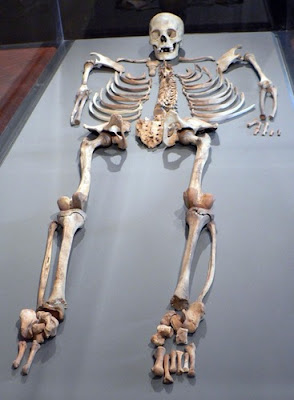The Forensic Science Academy Club held a meeting between 8:00AM-3:00PM on both Saturday and Sunday. During this week we had the discussion question: Is anatomy different in foreign countries such as Latin America's Peru? The director once again had the idea for her favorite game: "What's wrong with this skeleton?" Today's contestant comes from an NPR piece "Finders, Not Keepers: Yale Returns Artifacts to Peru".
My group pretty much carefully and precisely computed the following conclusions:
The femurs of the human are on the wrong sides! The ribs are presented in the wrong order; it is suppose to go from to small to big and small again! 1-3 ribs are usually small, 4-10 are big, and 11-12 are small once again. We were also bespectacled on why the fibulae of the remains are bent! The criticizing doesn't end here! There are 6 left metatarsals, the tibiae look much younger than the rest of the bones, and I'm not sure what's going on with the left tarsals.
In addition to what is been said so far, it is showing the posterior side of the scapula and they are on the wrong arms, same with the femurs. They don't know their right from their left, or front to back for the manner. It looks like one of those 6 metatarsals is actually a second metacarpal. The inferior portions of the ribs are actually pointing upward, when they should be pointed downward! The radii look like they're flipped as well, proximal to distal. The radial heads are pointing at the carpals when they should be pointed at the humeri.
With this presented evidence we can suggest that the radius and ulna should be reversed, since the radius is lateral when laid out in proper anatomical position, whereas it is shown to be medial. It looks like the olecranon fossae are pointed up in the anterior manner when they should be down in the posterior manner. Tibiae possibly don't go with this individual. Both have clear epiphyseal lines that aren't even close to closed at both ends making this a 12-15 year old adolescent. There might be a line of fusion evident in the proximal humeri, but there are no epiphyseal lines evident on the femora.
In addition to what is been said so far, it is showing the posterior side of the scapula and they are on the wrong arms, same with the femurs. They don't know their right from their left, or front to back for the manner. It looks like one of those 6 metatarsals is actually a second metacarpal. The inferior portions of the ribs are actually pointing upward, when they should be pointed downward! The radii look like they're flipped as well, proximal to distal. The radial heads are pointing at the carpals when they should be pointed at the humeri.
With this presented evidence we can suggest that the radius and ulna should be reversed, since the radius is lateral when laid out in proper anatomical position, whereas it is shown to be medial. It looks like the olecranon fossae are pointed up in the anterior manner when they should be down in the posterior manner. Tibiae possibly don't go with this individual. Both have clear epiphyseal lines that aren't even close to closed at both ends making this a 12-15 year old adolescent. There might be a line of fusion evident in the proximal humeri, but there are no epiphyseal lines evident on the femora.
Finally, the pathologies are odd too. How is it that the left fibulae is significantly bowed without any notable changes to the left tibia! At the rate that we were going through, we were fairly convinced that these bones come from 2 or more people. And I'm definitely convinced that whoever laid out this skeleton knows precious little about human osteology, what a great disappointment Peru!



